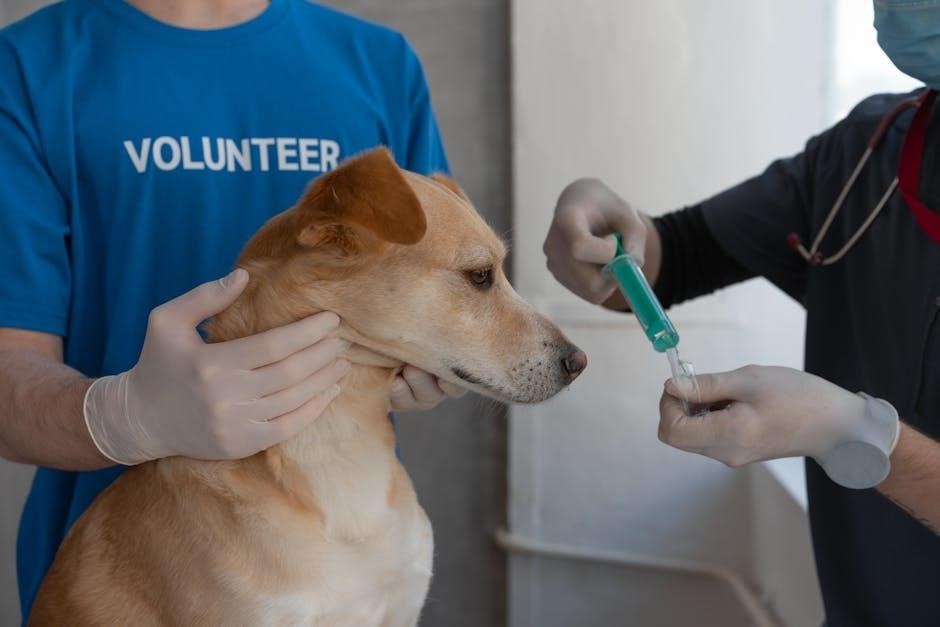
dog vaccination schedule chart pdf
Dog vaccination is crucial for protecting pets from infectious diseases. A well-structured vaccination schedule ensures puppies and adult dogs receive essential vaccines at the right time. This guide provides a detailed overview of core and non-core vaccines, schedules, and the importance of booster shots to keep your dog healthy and protected. Download a customizable dog vaccination schedule chart PDF to stay organized and informed.
Importance of Dog Vaccination
Dog vaccination is essential for protecting dogs from life-threatening infectious diseases. Vaccines help build immunity, reducing the risk of severe illnesses like distemper, parvovirus, and rabies. Unvaccinated dogs are vulnerable to deadly viruses, which can spread quickly in unvaccinated populations. Regular vaccination also contributes to public health by preventing the spread of zoonotic diseases, such as rabies, which can affect humans. Vaccines not only save lives but also prevent costly treatments for preventable diseases. By following a recommended vaccination schedule, pet owners ensure their dogs lead healthier, safer lives while protecting the community from disease outbreaks. Vaccination is a cornerstone of responsible pet care, safeguarding both individual animals and the broader animal population.
Core Vaccines for Dogs
Core vaccines are essential for all dogs, protecting against severe, contagious diseases like rabies, distemper, hepatitis, and parvovirus. These vaccines are vital for every dog’s health and safety.
3.1. Distemper
Canine distemper is a highly contagious and potentially deadly viral disease affecting dogs of all ages. It attacks the respiratory, gastrointestinal, and nervous systems, causing symptoms like coughing, vomiting, diarrhea, and seizures. The virus spreads through direct contact with infected dogs or contaminated items. Puppies and unvaccinated dogs are at the highest risk. The distemper vaccine is a core vaccine, meaning it is essential for all dogs. It is typically administered in combination with other vaccines, such as hepatitis and parvovirus, as part of the DHPP or DHLPP vaccine. Vaccination provides strong immunity and is crucial for preventing this life-threatening disease. Regular booster shots ensure ongoing protection. Consult your veterinarian to include the distemper vaccine in your dog’s vaccination schedule chart for optimal health.
3.2. Hepatitis
Canine hepatitis is a serious liver disease caused by the canine adenovirus type 1 (CAV-1). It can lead to severe illness, including liver failure and death if left untreated. Symptoms include lethargy, loss of appetite, vomiting, jaundice, and abdominal pain. The virus is highly contagious and spreads through direct contact with infected dogs’ urine, feces, or saliva. Puppies and young dogs are particularly vulnerable. The hepatitis vaccine is a core vaccine, often combined with distemper and parvovirus vaccines in the DHPP or DHLPP shot. It provides strong immunity and is essential for preventing this life-threatening disease. Regular vaccination ensures long-term protection. Including the hepatitis vaccine in your dog’s vaccination schedule chart PDF is crucial for maintaining their health and preventing the spread of this virus.
3.3. Parvovirus
Parvovirus, also known as parvo, is a highly contagious and potentially life-threatening viral disease affecting dogs. It primarily attacks the gastrointestinal system, causing severe vomiting, diarrhea, lethargy, and dehydration. Puppies under one year, especially those with weakened immune systems, are most vulnerable. The virus spreads through direct contact with infected feces, contaminated surfaces, or people who have handled an infected dog. The parvovirus vaccine is a core vaccine, typically administered as part of the DHPP or DHLPP combination vaccine. Puppies usually receive their first dose at 6-8 weeks, with boosters every 3-4 weeks until 16-18 weeks of age. Adult dogs require a booster every 3 years to maintain immunity. Including the parvovirus vaccine in your dog’s vaccination schedule chart PDF ensures they are protected against this devastating disease.
3.4. Rabies
Rabies is a core vaccine essential for all dogs due to its fatal nature and ability to spread to humans. The rabies vaccine is typically administered to puppies between 12-16 weeks of age, with a booster given one year later. Adult dogs require a rabies booster every three years, as per most veterinary guidelines. Rabies is a zoonotic disease, meaning it can be transmitted between animals and humans, making vaccination crucial for public health. The virus affects the central nervous system, leading to symptoms like aggression, paralysis, and eventual death. Legal requirements in many regions mandate rabies vaccination for dogs, ensuring community safety. Including the rabies vaccine in your dog’s vaccination schedule chart PDF is vital for compliance and protection against this deadly disease.

Non-Core Vaccines for Dogs
Non-core vaccines, such as Bordetella, Lyme Disease, and Leptospirosis, are optional and recommended based on a dog’s lifestyle, geographic location, and risk of exposure to specific diseases.
4.1. Bordetella
Bordetella, commonly known as the “kennel cough” vaccine, is a non-core vaccine recommended for dogs exposed to high-risk environments like kennels, dog parks, or puppy classes. It protects against Bordetella bronchiseptica, a highly contagious respiratory virus. The vaccine is typically administered intranasally or via injection, providing immunity for 6-12 months. Dogs in social settings or with increased exposure to other dogs benefit most from this vaccination. Annual boosters are often required to maintain protection. Consult your veterinarian to determine if the Bordetella vaccine is necessary for your dog based on their lifestyle and risk factors.
- Recommended for high-risk environments.
- Protects against kennel cough.
- Administered intranasally or via injection.
- Annual boosters may be required.
4.2. Lyme Disease
Lyme disease is a bacterial infection spread by ticks, particularly in regions with high tick populations like the Kirov region. The vaccine is recommended for dogs frequently exposed to wooded or grassy areas where ticks are common. It helps reduce the risk of infection but does not guarantee complete protection. Symptoms in dogs include fever, joint pain, and swelling. The Lyme disease vaccine is typically administered annually, with the first dose given after 12 weeks of age. Regular tick control measures should accompany vaccination for optimal protection. Consult your veterinarian to determine if the Lyme disease vaccine is necessary based on your dog’s lifestyle and geographic location.
- Recommended for dogs in high-risk tick areas.
- Reduces risk of Lyme disease infection.
- Administered annually after 12 weeks.
- Combine with tick control for best results.
4.3. Leptospirosis
Leptospirosis is a contagious bacterial infection spread through water or soil contaminated by infected animals. It affects dogs and can cause fever, vomiting, and kidney or liver failure. The vaccine is non-core and recommended for dogs exposed to high-risk environments, such as rural areas or stagnant water. It is typically administered annually, with an initial dose and booster shot. Leptospirosis outbreaks are often regional, making vaccination essential in endemic areas. Consult your veterinarian to determine if this vaccine is necessary for your dog based on their lifestyle and geographic location.
- Non-core vaccine for high-risk exposure;
- Annual revaccination required.
- Prevents severe kidney and liver issues.
- Regional outbreaks may necessitate vaccination.
Puppy Vaccination Schedule
Puppies typically begin vaccinations at 6-8 weeks of age, with core vaccines like DHPP administered every 3-4 weeks until 16-18 weeks old. A rabies vaccine is given at 12-16 weeks; Regular boosters ensure immunity against diseases like distemper, parvovirus, and hepatitis. The schedule may vary based on regional risks and your veterinarian’s recommendations.
- Starts at 6-8 weeks with DHPP.
- Booster doses every 3-4 weeks.
- Rabies vaccine at 12-16 weeks.
- Customized based on regional risks.
5.1. 6-8 weeks
The 6-8 week mark is the typical starting point for a puppy’s vaccination journey. At this stage, puppies receive their first core vaccinations, which are essential for protecting them from life-threatening diseases. The initial vaccine is often a combination vaccine, such as DHPP (Distemper, Hepatitis, Parainfluenza, and Parvovirus). This vaccine is critical because puppies are still vulnerable and rely on the protection provided by their mother’s antibodies, which may start to wane around this age. Vaccination at 6-8 weeks ensures early immunity and sets the foundation for a healthy immune system. It’s also important to note that puppies should not be exposed to unvaccinated dogs or high-risk areas until after their first round of vaccinations. Consult your veterinarian to confirm the exact timing and schedule for your puppy;
- First core vaccination (DHPP) is administered.
- Protects against Distemper, Hepatitis, Parainfluenza, and Parvovirus.
- Maternal antibodies may begin to decline.
- Avoid exposing puppies to unvaccinated dogs until after vaccination.
5.2. 10-12 weeks
At 10-12 weeks of age, puppies receive their second round of core vaccinations. This typically includes a booster shot for the DHPP vaccine (Distemper, Hepatitis, Parainfluenza, and Parvovirus). The second dose is essential for strengthening the puppy’s immune system and ensuring continued protection against these serious diseases. Some veterinarians may also recommend additional vaccines at this stage, such as Bordetella, depending on the puppy’s lifestyle and exposure risks. It’s important to follow the veterinarian’s guidance to maintain the puppy’s health and safety. Vaccines are spaced out to allow the puppy’s immune system to respond effectively without overload. This stage is critical for building long-term immunity and preparing the puppy for further vaccinations in the coming weeks.
- Second DHPP booster is administered.
- Optional non-core vaccines may be recommended.
- Continued protection against severe diseases.
- Immune system strengthening.
5.3. 14-16 weeks
At 14-16 weeks, puppies receive their final core vaccinations, completing the initial series. This typically includes the last booster for the DHPP vaccine (Distemper, Hepatitis, Parainfluenza, and Parvovirus) and the first rabies vaccination. Rabies is a critical vaccine for both dogs and public health, as it is fatal if contracted. Non-core vaccines, such as Bordetella, may also be administered at this stage if the puppy is at risk of exposure. This stage marks the end of the puppy vaccination series, providing comprehensive protection against severe diseases. Veterinarians may also discuss future booster shots and adult vaccination schedules during this visit. Ensuring all doses are completed by 16 weeks is vital for long-term immunity and health.
- Final DHPP booster is given.
- First rabies vaccination is administered.
- Non-core vaccines may be recommended.
- Completion of the puppy vaccination series.
5.4. 18 weeks and older
By 18 weeks and older, puppies transition to adult vaccination schedules. A rabies booster is typically administered at this stage, ensuring long-term protection. Core vaccines like DHPP may also receive a final booster to maintain immunity. Non-core vaccines, such as Bordetella, are given if exposure risk exists. This phase marks the completion of puppy vaccinations, preparing dogs for adult care. Veterinarians tailor future schedules based on lifestyle and health needs. Staying on track ensures continued protection against diseases. A vaccination chart PDF can help track completed doses and upcoming boosters, maintaining health and preventing illness.
- Rabies booster is administered.
- Final DHPP booster may be given.
- Non-core vaccines are provided if needed.
- Transition to adult vaccination schedules begins.

Adult Dog Vaccination Schedule
Adult dogs require regular vaccinations to maintain immunity against diseases. Core vaccines, such as rabies and DHPP, are typically administered every 1-3 years, depending on the vaccine type and local regulations. Non-core vaccines, like Bordetella, may be recommended annually if the dog is frequently exposed to other pets. Veterinarians tailor schedules based on factors like lifestyle, health, and regional disease risks. Boosters ensure ongoing protection and prevent disease outbreaks. A vaccination chart PDF can help track adult dogs’ schedules, ensuring they remain up-to-date and healthy. Regular check-ups with a vet are essential to adjust the schedule as needed.
- Core vaccines: administered every 1-3 years.
- Non-core vaccines: given based on exposure risk.
- Regular check-ups ensure schedule adjustments.
- Booster shots maintain long-term immunity.
Creating a Vaccination Schedule Chart
A vaccination schedule chart can be created using digital tools or PDF templates, helping owners track and organize their dog’s immunization records effectively.
7.1. Digital Tools
Digital tools simplify the creation and management of a dog vaccination schedule chart. Online platforms like Google Sheets or specialized pet care apps allow customization and easy updates. Features such as automated reminders, live traffic updates for vet visits, and interactive charts ensure compliance with vaccination timelines. Some apps integrate with calendars, sending alerts for upcoming doses. Additionally, tools like Canva or Adobe Spark offer templates for designing visually appealing and organized charts. These digital solutions are accessible, shareable, and eco-friendly, making it easier for pet owners to track their dog’s health records efficiently. By leveraging technology, owners can stay informed and ensure their pets receive timely vaccinations.
7.2. PDF Templates
PDF templates are a convenient way to create and share dog vaccination schedule charts. Many online resources offer customizable templates that can be downloaded and filled out with specific details. These templates often include sections for core and non-core vaccines, dosage information, and booster shot reminders. They are designed to be visually appealing and easy to understand, making it simpler for pet owners to track their dog’s vaccination history. Some templates also include space for notes or additional health information. Websites like DogsCare101 and official veterinary associations provide reliable and free PDF templates. By using these templates, pet owners can ensure their dogs receive timely vaccinations and maintain accurate health records. These tools are especially helpful for owners who prefer a traditional, printable format.
Role of Veterinarians
Veterinarians play a crucial role in creating customized vaccination plans and ensuring dogs receive necessary vaccines. They monitor health and adjust schedules as needed, providing expert guidance for optimal protection.
8.1. Customized Plans
Veterinarians create tailored vaccination plans based on a dog’s lifestyle, age, health, and regional disease risks. Core vaccines, like DHPP and rabies, are essential for all dogs, while non-core vaccines, such as Bordetella, are recommended for dogs in high-risk environments. Factors like outdoor exposure, travel, or boarding influence the selection of vaccines. For puppies, the initial series is critical, starting at 6-8 weeks with boosters every 3-4 weeks until 16-18 weeks. Adult dogs require boosters as per guidelines, typically every 1-3 years; Veterinarians ensure schedules align with local laws and health needs, providing a downloadable dog vaccination schedule chart PDF for easy tracking. This personalized approach ensures optimal protection while minimizing unnecessary vaccines.
8.2. Monitoring
Regular monitoring of a dog’s vaccination status is essential to ensure immunity and overall health. Veterinarians track booster schedules and health status to prevent gaps in protection. Dogs in high-risk areas require more frequent monitoring due to increased exposure to diseases like Lyme and leptospirosis. Annual check-ups help verify vaccine efficacy and update records. Digital tools and PDF charts simplify tracking, ensuring timely reminders for boosters. Monitoring also helps identify adverse reactions and adjust plans as needed. This proactive approach ensures dogs remain protected and up-to-date on all necessary vaccines, preventing outbreaks and maintaining public health safety.

Diseases Prevented by Vaccines
Dog vaccines protect against several life-threatening and contagious diseases. Core vaccines prevent distemper, hepatitis, parvovirus, and rabies, which are highly infectious and deadly. Non-core vaccines target diseases like Bordetella, Lyme, and leptospirosis, depending on regional risks. These vaccines ensure dogs are safeguarded from severe illnesses, reducing mortality rates and preventing outbreaks. Regular vaccination is vital for maintaining individual and community health, especially in areas with high disease prevalence. By following a tailored vaccination schedule, pet owners can ensure their dogs remain protected throughout their lives, promoting long-term health and well-being.
Importance of Booster Shots
Booster shots are essential for maintaining a dog’s immunity against diseases. Vaccines provide temporary protection, and boosters are needed to revitalize the immune system. Without boosters, immunity wanes, leaving dogs vulnerable to infections. Core vaccines like rabies and DHPP require periodic boosters to ensure lasting protection. Non-core vaccines may also need renewal based on exposure risk. Boosters are tailored to individual needs, considering factors like lifestyle and regional disease prevalence. Regular boosters prevent outbreaks and protect both the dog and the community. Veterinarians recommend specific schedules to optimize protection, ensuring your dog remains safe from preventable diseases throughout its life.

Obtaining a Vaccination Chart PDF
Obtaining a vaccination chart PDF is a convenient way to track your dog’s immunization schedule. Many veterinary clinics and pet health websites offer downloadable PDF templates. These charts typically include spaces to record core and non-core vaccines, booster shots, and due dates. You can also find customizable PDFs online that cater to your dog’s specific needs, such as regional disease risks or lifestyle factors. Some organizations, like the American Animal Hospital Association (AAHA), provide updated vaccination guidelines in PDF format. Downloading a vaccination chart PDF ensures you stay organized and informed about your dog’s health. It’s a handy tool for maintaining records and discussing schedules with your veterinarian.

Cost Implications of Dog Vaccination
The cost of dog vaccination can vary depending on factors such as location, veterinary clinic, and the type of vaccines required. Core vaccines, like rabies and distemper, are generally more affordable, ranging from $20 to $50 per dose. Non-core vaccines, such as Bordetella or Lyme disease, may cost slightly more, up to $100. Puppy vaccination series, which include multiple doses, can range from $50 to $150. Adult booster shots are typically cheaper, around $20 to $50. Additionally, some clinics offer discounted packages for comprehensive vaccination plans. It’s important to discuss costs with your veterinarian to ensure your dog receives necessary protection while staying within your budget. Regular vaccinations are a critical investment in your dog’s long-term health.

Common Misconceptions About Dog Vaccines
Many pet owners have misconceptions about dog vaccines. One common myth is that vaccines are unnecessary if a dog is indoor-only, but indoor dogs can still be exposed to diseases through open windows or contact with infected animals. Another misconception is that vaccines are 100% effective, but no vaccine offers complete immunity. Some believe that natural immunity from infection is better than vaccination, but this is untrue as infections can be life-threatening. Additionally, some think all vaccines are required for every dog, but non-core vaccines depend on lifestyle and region. Consulting a veterinarian helps clarify these myths and ensures your dog’s vaccination plan is appropriate and effective.

Legal Requirements for Dog Vaccination
Legal requirements for dog vaccination vary by region but often mandate rabies vaccination to prevent the spread of this deadly disease. Many countries and states require dogs to be vaccinated against rabies by a certain age, typically 12-16 weeks, with booster shots as specified by law. Proof of vaccination is often required for licensing, travel, or boarding facilities. Some areas may also require additional vaccines based on local disease risks. Failure to comply with legal vaccination requirements can result in fines or penalties. Veterinarians can provide guidance on meeting legal obligations while ensuring your dog’s health. Always check local regulations and keep vaccination records up to date to avoid legal issues. Downloading a dog vaccination schedule chart PDF can help track compliance with legal and health requirements.

Regional Variations in Vaccination Schedules
Regional variations in dog vaccination schedules are influenced by local disease prevalence, climate, and legal requirements. For example, in areas with high incidence of Lyme disease or Leptospirosis, these vaccines are often recommended, while in regions with lower risk, they may not be necessary. Some countries or states have specific mandates, such as mandatory rabies vaccination, while others may require additional vaccines based on local health concerns. Veterinarians tailor schedules to address regional risks, ensuring dogs are protected against diseases prevalent in their area. These variations highlight the importance of consulting local veterinary guidelines or authorities to create an accurate vaccination plan. A customizable dog vaccination schedule chart PDF can help accommodate these regional differences, ensuring compliance with local health regulations and disease prevention needs.
Future Developments in Dog Vaccines
Research into dog vaccines continues to evolve, with advancements in technology offering promising developments. Scientists are exploring new vaccine formulations, such as mRNA-based vaccines, which have shown success in human medicine and could provide improved protection for dogs. Additionally, efforts are being made to develop vaccines targeting emerging or region-specific diseases, such as Lyme disease and Leptospirosis, with greater efficacy. Personalized vaccination plans, based on a dog’s genetic makeup and lifestyle, are also being investigated to optimize immune responses. Future vaccines may also focus on reducing the frequency of booster shots by extending immunity durations. These innovations aim to enhance the safety and effectiveness of dog vaccines, ensuring better protection against preventable diseases. A dog vaccination schedule chart PDF can be updated to reflect these advancements as they become available.

Frequently Asked Questions
Many pet owners have questions about dog vaccination schedules. Common inquiries include understanding which vaccines are essential, how often boosters are needed, and the risks of missing a dose. Owners also ask about the difference between core and non-core vaccines. Additionally, questions arise about the safety of vaccines, potential side effects, and how to obtain a vaccination schedule chart PDF. Some wonder if indoor dogs need the same vaccinations as outdoor dogs. There are also inquiries about the legal requirements for rabies vaccination and how regional variations might affect the schedule. Veterinarians often receive questions about the cost of vaccinations and how to stay organized with a vaccination plan. These FAQs highlight the importance of consulting a veterinarian to address specific concerns and ensure proper protection for pets.
Dog vaccination is a critical aspect of pet care, ensuring protection against life-threatening diseases. A well-organized vaccination schedule, available as a PDF chart, helps pet owners keep track of essential vaccines and booster shots. By adhering to a structured plan, dogs receive the necessary immunity at the right time, preventing the spread of infectious diseases. Veterinarians play a key role in tailoring schedules to individual needs, considering factors like lifestyle and regional risks. Staying informed and proactive about vaccinations not only safeguards your dog’s health but also contributes to public health. Downloading a vaccination schedule chart PDF is a practical step toward responsible pet ownership, ensuring your furry friend leads a healthy and protected life.
Related Posts

carrier comfortlink alarm codes pdf
Download the comprehensive Carrier ComfortLink alarm codes PDF guide for easy troubleshooting and system maintenance. Get instant access now!
squallywood pdf
Download Squallywood PDF instantly. Get your free copy now!

gottman worksheets for couples pdf
Strengthen your relationship with free Gottman worksheets for couples. Download printable PDFs based on research-backed strategies to improve communication and connection.